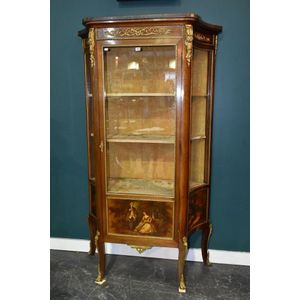Kingwood Vitrine with Hand-Painted Panels
French 'vernis martin' vitrine, superb glazed display collector's cabinet in kingwood, marble top, ormolu mounts with hand painted panels below depicting lovers in pastoral landscapes
You must be a subscriber, and be logged in to view price and dealer details.
Subscribe Now to view actual auction price for this item
When you subscribe, you have the option of setting the currency in which to display prices to $Au, $US, $NZ or Stg.
This item has been sold, and the description, image and price are for reference purposes only.
- Mounts - Mounts are used to describe bronze, brass and ormolu adornments on furniture especially quality furniture in the rococo and classical revival style, and are also the cabinet makers' name for the metal fittings on furniture, such as hinges, locks and handles, and metal edges and guards which protect furniture from damage.
- Ormolu - Ormolu was popular with French craftsmen in the 18th and 19th century for ornamental fittings for furniture, clocks and other decorative items. True ormolu is gilt bronze, that is bronze that has been coated with gold using a mercury amalgam. Due to the health risks associated with using mercury, this method of creating ormolu was discontinued in France in the 1830s. A substitute was developed consisting of about 75% copper and 25% zinc, however it was inferior to the bronze version. It was often lacquered to prevent it tarnishing.
- Panels - Timber pieces, usually of well-figured wood either recessed or applied over the frames of doors and as decoration elsewhere in the carcase of cabinet furniture. The panels may take a variety of shapes rectangular, square, shield shape, oval, half-round or in the form of Egyptian pylons.
- Vernis Martin - A generic name for a type of lacquer finish applied to furniture and a multitude of small articles, giving a brilliant translucent finish, imitating the Chinese and Japanese lacquer finishes on furniture imported into France during the Louis XV period..
Usually the surface to which the lacquer is applied was embellished with painted decoration of a classical scene.
The name is derived from the inventors, Simon-Etienne Martin and his two brothers, a distinguished family of French artist-artificers of the 18th century, who refined and perfected the technique, and were granted a monopoly in its manufacture in 1730.
This item has been included into following indexes:
